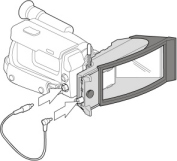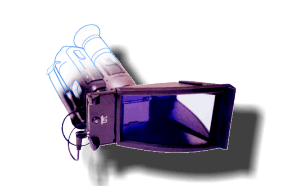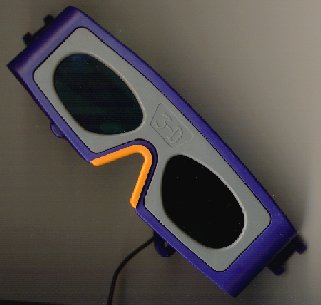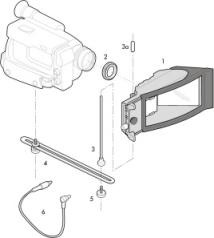

The unofficial Nu-View & Nu-Shades page
maintained
by
Christoph Bungert


The unofficial Nu-View & Nu-Shades page
maintained
by
Christoph Bungert
 |
 |
Quick info: The Nu-View by 3Dvideo Inc. is a video camera add-on. It turns almost any ordinary camcorder into a 3D-movie machine. It works for all current video and TV-systems worldwide. The 3D-videos can be watched immediately on any standard TV-set, using TV-shutterglasses. The Nu-View usually doesn't interfere with zoom and autofocus functions of the camera. It is a "heavy" and sturdy design with a professional feel to it. The Nu-View is a major step forward in terms of availability, price and handling compared to earlier 3D-video recording solutions which were based on 2 seperate cameras or expensive 2-lens-cameras.
As a bundle to the NuView 3Dvideo Inc. offers the Nu-Shades TV-shutterglasses. The Nu-Shades controller supports wired and wireless glasses. Currently wired glasses are shipped.I have tried the all-in-one starter box consisting of Nu-View camcorder adapter, TV-shutterglasses controller and 2 Nu-Shades shutterglasses.
Important Update: 3Dvideo Inc. is out of business. Nu-View is now distributed by i-O Display Systems at a much lower price, the NuShades glasses and controller are replaced by i-O Display glasses
There are now two similar products on the market: the U-Bin Stereocam and the Wasol 3D-Cam.
Check out my NuView vs. Stereocam comparison.
This page was innitially
released on July 05, 1998,
last update: November 16,
2002
|
|
|
|
|
|
|
|
|
|
|
|
|
|
|
|
|
|

The feel of itThe adapter is heavier, sturdier and more professional than I thought after seeing the pix on the net. The NuView feels like some high-quality photo equipment. The case is made of two kinds of very resistant plastics. One of them is a tire-like shock absorbing rubber material (the dark part in the figure above). The NuView can be used as a stand if you're using a smaller camcorder. I guess the manufacturer would object to my "heavy" statement, but I don't think the weight is a major problem.
The weak point seems to be the large front window of the NuView, which should be protected while not in use. There's a textile lens cover in the box. The window is described as "shock resistant, optically clear and double-sided anti-reflective coated polycarbonated window" by the manual.
The mirror construction reminds me of the Argus/Loreo photo-stereo-camera. The quality of the Nu-View seems to be higher in every respect though. In the Nu-View only those surfaces are reflective which are required to be reflective.
Reflections are still a problem though. To achieve best results, the light source should be behind the camera, not in front or on the side.Components and technical principle
The system consists of two LCD-shutters, a prismatic beam splitter and an adjustable mirror. Watching through the Nu-View, while it is switched off, you will see two images. The mirror/prism system puts the camera lens into the center of the light rays of a left and a right eye view. The shutters see to it that the camera lens gets only one of the views at a time. The adaptor is connected to the video-out port of the camcorder. This way the shutter can sync to the recording (50 or 60 Hz).
To understand the technology you first have to understand our television systems. One second of television consists of 25 (PAL) or 30 (NTSC) frames. These frames are divided into 50 (PAL) or 60 (NTSC) half frames. One half-frame consists of either all even or all odd lines of a frame. In other words television works in interlace mode by default. 3D-video systems are based on this interlace technique. They use all even-line-half-frames for one eye and all odd-line-half-frames for the other eye. Like any shutterglasses system it is time-sequential stereo! Both the Nu-View on the recording side as well as the TV-shutterglasses controller on the playback side look for the vertical synchronization retrace signal!The resulting 3D-video tape is similar to the commercial 3D-video tapes sold over the net and can be viewed with all TV-shutterglasses systems or a video-ready HMD like the i-glasses. No further modification of camcorder, VCR or TV-set required!

Installation and OperationThe Nu-View adapter is secured in front of the video-cam using the filter-thread and a link arm which is connected to the tripod thread of the cam. You can still use a tripod after this procedure since there's another thread on the base of the bolt.
NuView can be right or left mounted to the camera. To account for this there's a stereo-reverse switch.
The unit is powered by one 1.5V AAA (in Europe: mikro) battery. The manual claims a battery lifetime of 60 hours. There's an on/off switch and an auto-shut-off function.
The 3D-ready LED stays green while a video signal is detected.
The Low-Battery LED is active in case... well you guessed it.
The mirror inside NuView can be adjusted horizontally and vertically.
The vertical adjustment is only rarely required. Maybe after longer use of the system or if the highest precision is wanted for extreme telephoto zoom shots.
Vertical adjustment is used if one image of the stereo pair seems to be higher than the other.Convergence Control (choose your out-of-the screen effect)
The horizontal adjustment is a quite interesting feature. It controls the convergence of the two images. This way you can choose which objects in the frame will later appear IN the TV-screen, which will be on the monitor-plane and which will come OUT of the TV.
For this purpose you're choosing the object which will be on the monitor plane. Usually all objects in the viewfinder appear to be doubled. Now the Nu-View's main mirror is adjusted in a way that a certain object only appears once, i.e. the two images are superimposed. This object will later appear on the TV-screen plane. All objects behind this "reference object" will appear in the TV (behind the plane), the objects in front of it will come out of the TV.
I wouldn't stress this option too much. Object behind the screen are usually more pleasing to watch than objects coming out of it. The effect of objects hovering in front of the screen is destroyed if they come to close to the border of the frame.The convergence is controled by a large, sturdy, smooth moving and well positioned knob.
Copying & Editing
The recorded material can be copied and edited, just like any standard video recording. No special equipment required.
Time Gap & Digital Camcorders
3D-Video Inc. and myself received some emails expressing fears concerning paning and moving. Due to the time-sequential recording technique used by the system the 3D-effect could (in theory) be distorted by movements.
The developers point out that this isn't a problem. Even paning shots, shots out of a fast car and other movements didn't show any unwanted effects.
I did some paning myself and it looked good. In theory there should be a negative effect, connected to the time-lag, when moving the camera. I think under normal conditions the effect is just too small to be seen.Ross Cutler gave me an interesting hint He was also concerned about the time-lag problem and came across the new Canon Optura miniDV consumer camcorder which uses a progressive scan CCD. The camcorder plays to the rules of the current TV-systems by recording 50/60 half-frames a second, but it seems to scan the two half-frames (which represent one full-frame) at the same fraction of time, thus eliminating the usual time-gap between half-frames. Sounds like an advantage at first, but may render the camera useless for Nu-View. If the image pick-up frequency on the CCD is different from the frequency on the video-out port of the camcorder, the Nu-View won't work! Therefore incompatibilities between certain digital camcorders and the Nu-View are conceivable, but not confirmed yet. Ross already pointed out that, in theory, a passive optical beam-splitter should (must) be used for progressive scan cams. Such a solution would require additional complex hardware on the playback side.
|
|
To use the NuView camcorder adapter you will at least need:
a video camcorder with a standard filter thread (the "native" filter thread of the Nu-View is 37 mm, ask for an adapter-ring if required) the filter thread of the cam shouldn't be a moving part (there are some older cameras where lens and filter-thread rotate while focusing) the autofocus system of the camera should work through the lens, external IR-sensors may be blocked by the Nu-View adapter the camcorder is required to have a composite video-out jack which is active during recording the camcorder must be able to record in standard interlace format NTSC, PAL or Secam progressive-scan on the camcorder must be disabled a standard TV-set with video-in jack some TV/video compatible shutterglasses, like the Nu-Shades (click here for a market overview of TV-shutterglasses)
|
|
There are several ways to playback the 3D-video tapes done with Nu-View.
The usual way is to use some TV/video compatible shutterglasses, like
the Nu-Shades, and a standard TV-set. Users
of wired PC-shutterglasses may consider building their own homebrew
TV/video controller.
Please consult my 3D-TV/video playback market overview.What works:
What won't work:Standard CRT PAL/Secam TV or projector (50 Hz) - that's the worst case and that's the way I've tested the system. It flickers a lot, but it is so fascinating you will watch it anyway. (CRT stands for Cathode Ray Tube, you're most likely looking at a CRT-computer-monitor or a LCD-notebook screen at this very moment.) Standard CRT NTSC TV or projector (60 Hz) - that's better, but there's room for improvement. PAL-3D-100Hz-TV - this is a rare and expensive item, but it should work great (this kind of TV is available in Germany as TMP/S3R Live-Eyes-3D-TV). NTSC-3D-120Hz-TV - this is a rare and expensive item, but it should work great as well (announced by APEC). 3D-Headsets, like i-glasses, Cybermaxx or VFX-1 with video-in option - this should be great, since there'll be no flicker and no ghosting. Unfortunately I couldn't test it, as my camcorder is a PAL machine and my CyberMaxx2 accepts NTSC only. 2-LCD-projectors with polarization filters plus a special signal splitter (like offered by APEC) PC-digitized video - there should be digitizer boards, which transfer 3D-video to the PC without hurting the 3D-information, soon. The videos could be watched using PC-shutterglasses then. This should give the user control over the refresh rate to eliminate flicker. VRex micro-polarizer 3D-LCD projectors (flicker free)
Standard LCD-screens and -projectors - they're not compatible to shutterglasses. Standard 100Hz PAL or 120Hz NTSC TV-sets - the shutter controller can't sync to the 100/120 Hz image on the screen, because the external video equipment continues to work at 50/60 Hz. Only shutter-controller-circuitry built INTO the 100/120 Hz TV-set will work. There's also a problem related to the digital buffering strategies of such TV-sets. Some of them would destroy the 3D-information anyway. Other display technologies, like Micro Mirror Device projectors, Laser-TV, Plasma, etc. won't work right away. Some of them are incompatible to shutter-technology, others would have to be modified, because of their unusual refresh strategy.
|
|
|
|
The Nu-View camcorder add-on is a time-machine and a teleporter in one small package. It'll bring you back to places and times once visited. The illusion of being there is much stronger than with ordinary 2D-video. I'd describe the 3D-effect as just natural. you will experience a deja-vu.There are certain phenomenons connected to 3D-Video. You're drawn closer and closer toward the TV-screen. it is almost impossible to keep the usual TV viewing distance. You won't lean back in the chair, you will lean forward. The eyes are not as fixed to the screen as usual. They'll begin to wander around like in the real world. Use the largest TV screen you can get, a CRT-projector should be optimal.
I've tested the system in a worst case configuration. I used PAL-equipment which delivers the worst refresh rate (50 Hz). I didn't make the room completely dark most of the time and I used an old camcorder which wasn't fully compatible to the system. I lost the autofocus function and manual focusing was difficult.
Despite this problems the results were impressing. The flicker is a major problem, but the fascination for the 3D-images is stronger. I think most users won't feel the urge to go back to 2D.
Installing and handling of the system is quite easy. The sturdy, professional design creates confidence, it is just fun to use.
What's not covered yet in my investigation are the longtime effects. How long can the material be watched until headaches, etc. occur? Will the effect wear off? Will there be the urge to go back to standard use of the camcorder after some time? What's the longtime reaction of friends and relatives after the novelty wears off.
Check back to this section for updates on the matter. Contributions by other Nu-View users are welcome.
|
|
The Nu-View adapter is a brilliant solution for the recording of 3D-Videos. Problems appear on the playback side when using a standard television for watching. The situation for NTSC-users isn't as bad as for the PAL-community however.
The great thing about the Nu-View is the ability to shoot 3D-Videos NOW and use them in a variety of ways, like storing them away until you get your hands on more satisfying means of playback. In 10 or 20 years from now you will be the only guy in town who has 3D-footage from the late 20th Century.Now check out my NuView vs. Stereocam comparison
|
|

The Nu-Shades (aka 3D-Spex)
Components:Wired Nu-Shades LCD shutterglasses (they're identical to the well known 3D-SPEX glasses). The Nu-Shades/3D-SPEX are still the most comfortable shutterglasses I know. They have large LCD-panels also. See the 3D-SPEX and the X-Ray Lab pages for further details on the glasses.
110V/12V power supply (no luck for me poor 220V-guy again).
 |
 |
|
|
|
TV/Video shutterglasses controller - this box is placed between the camcorder/VCR and TV-set and does the magic on your 3D-video tapes. It works for all TV and video systems worldwide.The Nu-Shades box has the following features:
Always check the stereo orientation by using the reverse-switch at startup. Beginners can easily miss the fact that the image is reversed, which results in eye & brain-strain and an unsatisfying 3D-experience.2 x 3.5mm stereo jack for wired shutterglasses, can be enhanced to 8 glasses by using 3.5 mm Y-adapters Stereo-reverse-switch Video-Sync-LED (video signal detect) Power-LED 12 V power in Video-in (cinch) Video-out (cinch) miniDIN-3 stereo connector (StereoGraphics & VESA-3 compliant I hope) for current professional or upcoming consumer (wireless) glasses (great!) I think every shutterglasses controller (TV and computer) should support wired and wireless glasses simultaneously.
The H3D-IR-emitter isn't supported, despite the fact that it uses a miniDIN-3 connector.
Videos shot with a correctly installed Nu-View should alway work right in the 3D1 position however.

VHS-demo video (NTSC) - quite short (6 minutes?), I couldn't watch it yet.The set also includes a 3.5 mm Y-adapter, a 4 m extension cable for the glasses and a cinch video cable.
European users may need a cinch-to-Scart and a Scart-to-cinch adapter. They also need a TV-set which accepts a video-in signal without an accompanying control current on a certain pin of the Scart-connector. There should be no problem with newer TV-sets. (If you're an European you know what I'm talking about anyway.) Man, why can't this underdeveloped Americans (NTSC, 110V, Cinch/BNC) not just convert to our superior technology (PAL, 220V, Scart). Life could be so easy :-) .
A list of Nu-Shades-compatible prerecorded 3D-video-tapes (movies, documentaries, specials, adult entertainment) can be found here.
Brand and product names are trademarks or registered trademarks of their
respective holders.
Some of the images are taken from the official product website.
The author can't guarantee the accuracy of the information given on
this page.